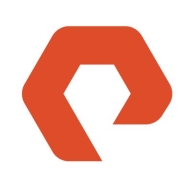A robust and dependable product that ensures a 100 percent data availability guaranteeWe don't encounter any challenges in selling these Hitachi VSPs to our customers. These products boast an exceptionally robust architecture, making them highly reliable. This reliability is the key reason behind our lack of challenges. However, when we delve into the realm of competition, particularly in the unified storage sector, we do face certain challenges. This is primarily due to the usage of gateways in their storage solutions by some competitors. Unlike other competitors such as NetApp and Huawei, who do not employ gateways, we contend with challenges related to these gateways within the context of unified products. Many customers have been utilizing Hitachi Vantara for several years, relying on its storage capabilities. They appreciate its reliable roadmaps, which facilitate long-term planning. This makes it an effortless choice for customers to opt for Hitachi Vantara, as the product seamlessly accommodates updates and future changes. The key focal point of the Hitachi Vantara roadmap for our clients is centered around future upgrades. Typically, customers undergo tech refresh cycles approximately every five years. Consequently, when they embark on a tech refresh initiative, they tend to prioritize options that facilitate a smooth transition of data to alternative storage solutions. In this context, Hitachi Vantara leverages its external storage virtualization platform to ensure a seamless data migration process. This approach proves to be highly advantageous for our customers, and it stands as a primary reason for their choice to engage with Hitachi Vantara's offerings. Our customers are highly satisfied with their choice to acquire Hitachi products and services. I have not observed any of our customers shifting away from the Hitachi brand. I would recommend Hitachi Vantara 100 percent of the time to others. There are tools that assist us in accessing the IOPS per second and latencies of Hitachi Vantara systems. One such tool is the CPK tool, accessible through the Hitachi Vantara portal. Whenever we configure a product and a customer requests information about the IOPS and latencies, we can provide them with a report from the portal. This report includes details about reads, writes, IOPS, and sequential operations, offering a comprehensive overview of the IOPS performance that Hitachi Vantara offers. The combination of low latency and high performance has consistently assisted customers in improving their production and enhancing their working experience. It also aids them in easily managing the product, giving them time to expand their knowledge and plan for the future, rather than dealing with storage-related issues. The cost comparison of IOPS between our solutions and those of competitors is favorable at present, but this wasn't always the case. In the Pakistani market, Huawei used to be highly competitive. However, our current partnership with Hitachi has allowed us to pose a strong challenge to Huawei. Additionally, when considering products from NetApp, EMC, and even IBM, Hitachi remains highly competitive. Hitachi offers flexible media options to support the consolidation of multiple uses within the same platform which is important to our customers. Most of our customers utilize Unified Storage, employing a two-tier storage approach that includes both NVMe and SSDs. However, current trends indicate a shift in customer preferences towards NVMe over SAAS or SSDs due to the heightened reliability and increased cost-effectiveness of NVMe technology. This transition is driving many customers to adopt a comprehensive NVMe solution. Nonetheless, a substantial number of large customers still adhere to the two-tier storage model. For their primary tier, they employ NVMe drives, while for the secondary tier, they opt for NFS drives or a SAAS-based large-scale service. The integration of various use cases into a unified platform to facilitate the transformation of data into business insights is highly valuable. We receive input from our customers regarding their workloads. Based on the nature of these workloads and their intended use for storage – whether for ERP solutions, archives, or backup purposes – we recommend the appropriate storage type. These steps outline our process for evaluating the intended storage workload. Following this workload assessment, we suggest either NAS Unified Storage or Document Storage solutions. In the portal, there is a tool that enables us to calculate Hitachi's guaranteed effective capacity. It is quite straightforward for customers to comprehend and identify the effective capacity ratio. This is because many customers in Pakistan are already familiar with and using effective capacity ratios. Explaining the concept of effective capacity to customers is not a challenging task. Customers typically appreciate the Hitachi Virtual Storage Platform due to its efficiency, easy product manageability, and product reliability, all of which offer significant benefits to the customers. This is crucial, especially in sectors like banking, where any breach or downtime could lead to substantial losses for customers. The uninterrupted operation of storage is paramount. This substantial benefit not only ensures customer satisfaction but also underscores the value derived from data utilization. Hitachi's adaptive data reduction technology assists in decreasing our client's storage footprint by around 50 percent. The majority of our customers were using storage from various vendors. We consolidated this storage into a single system using Hitachi Vantara.





